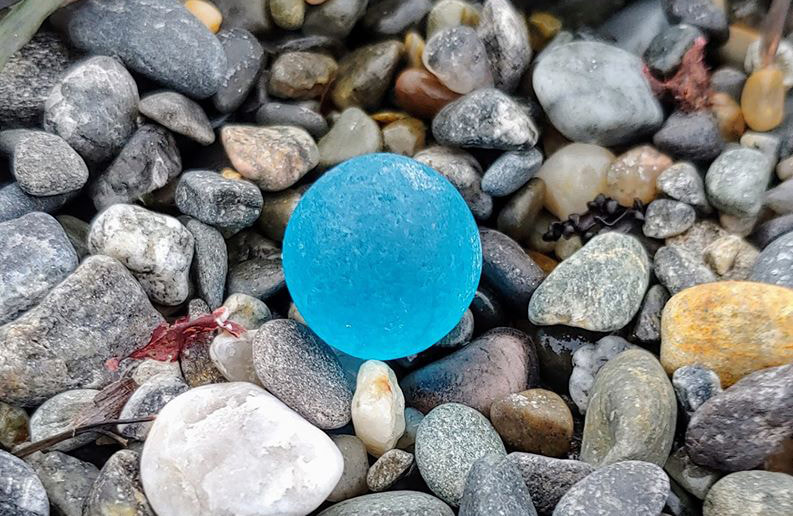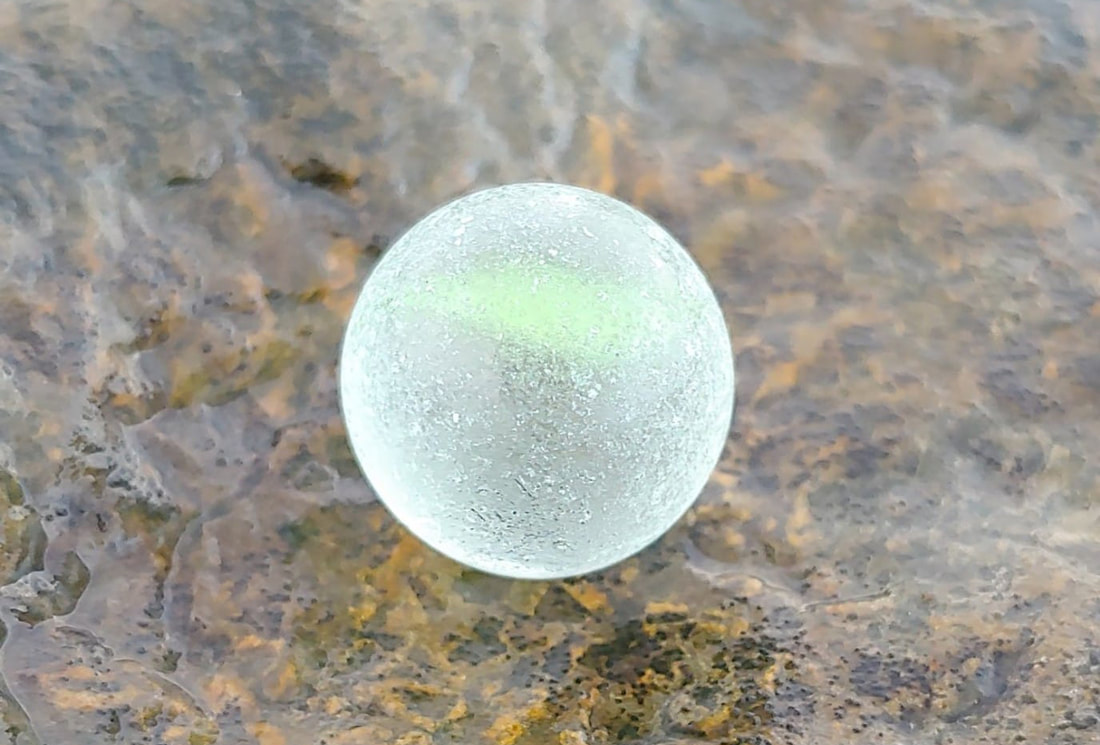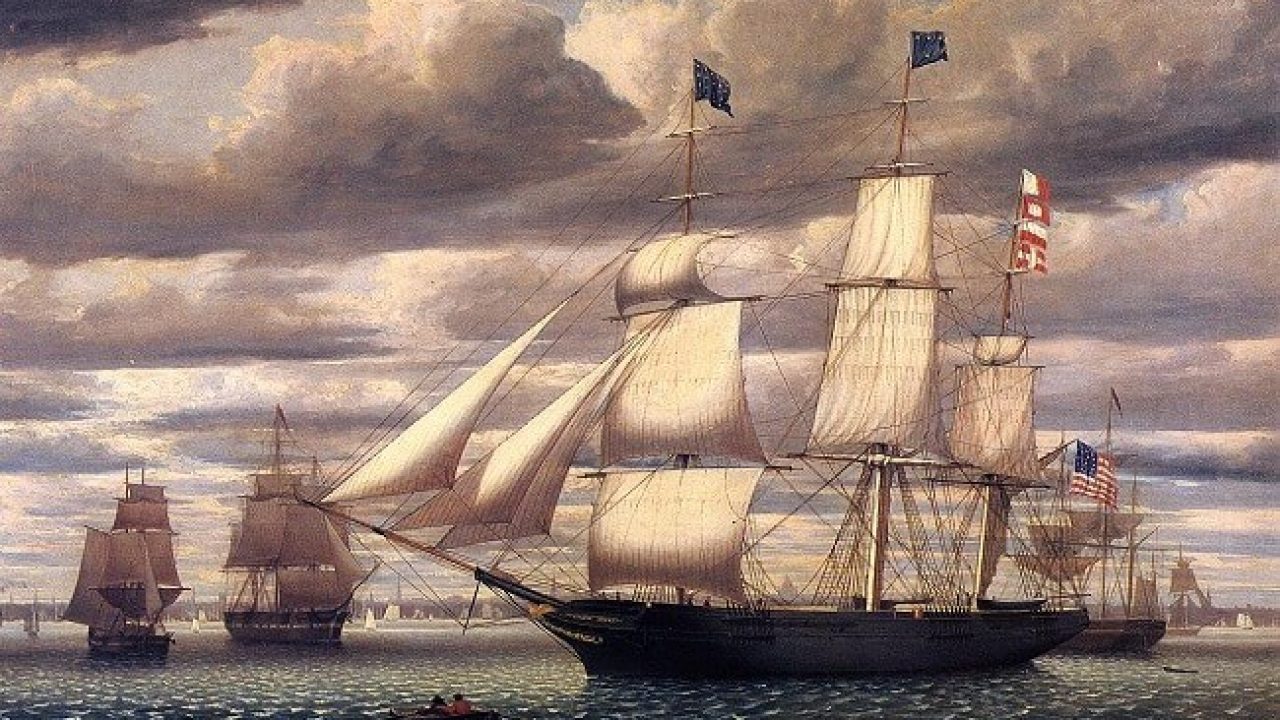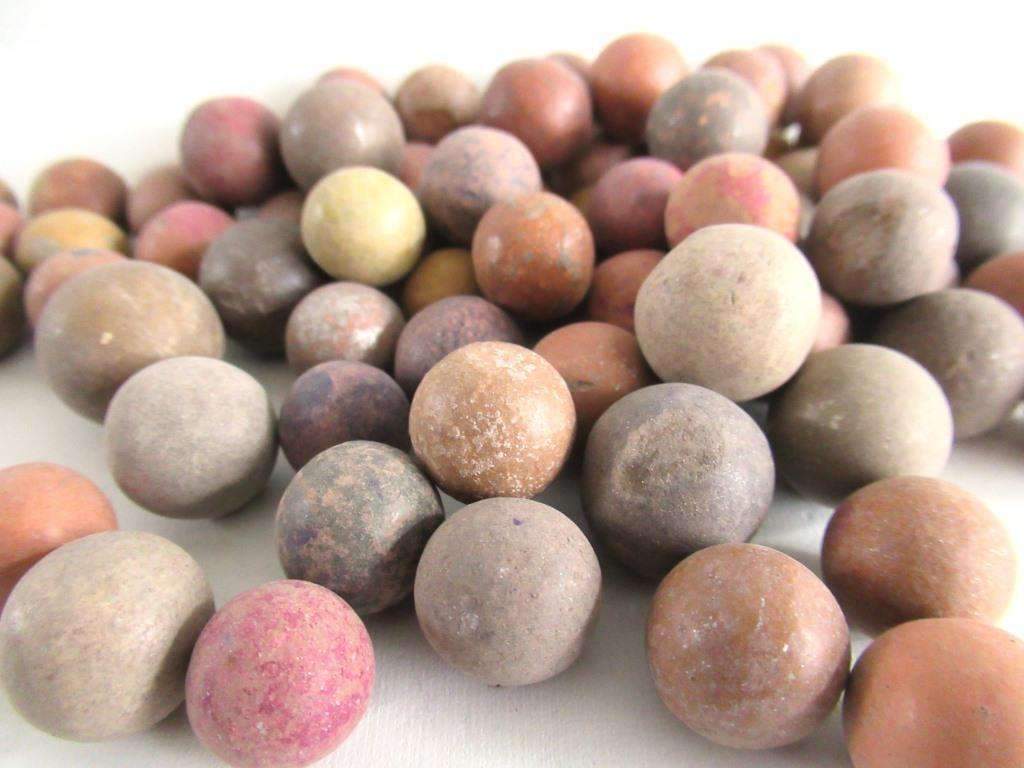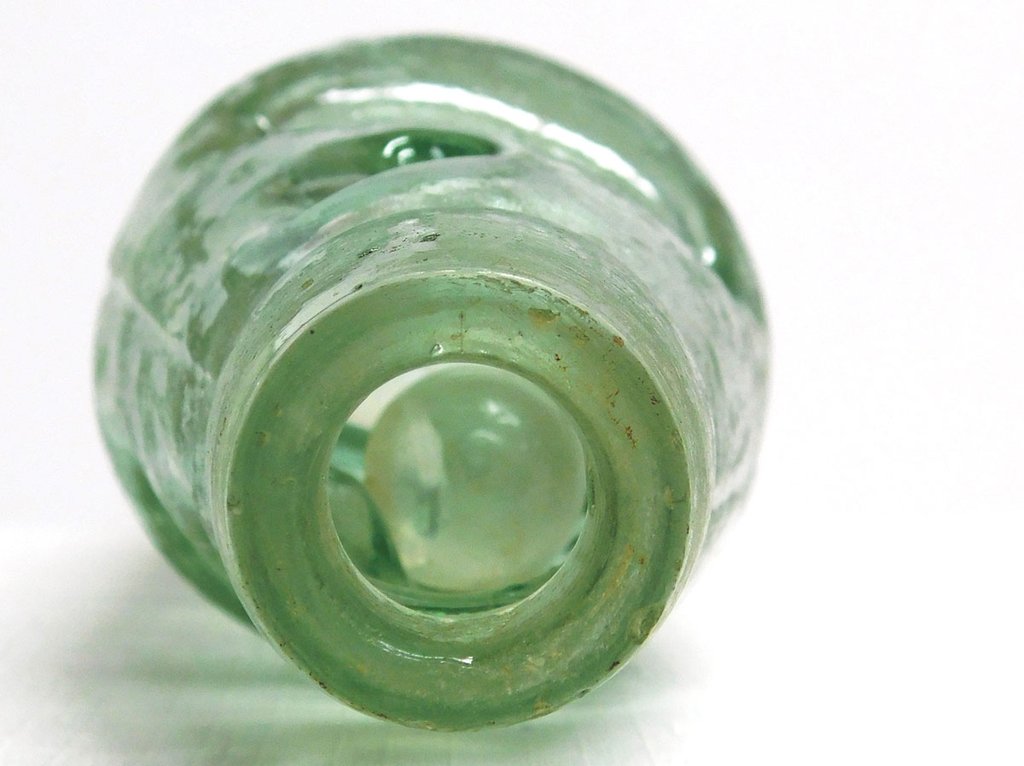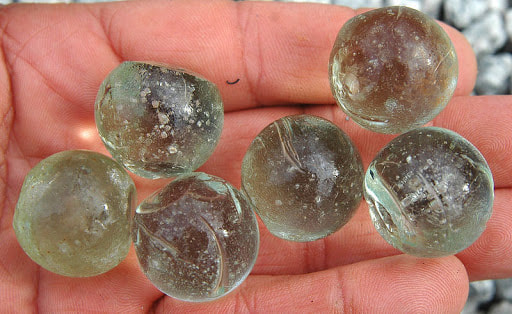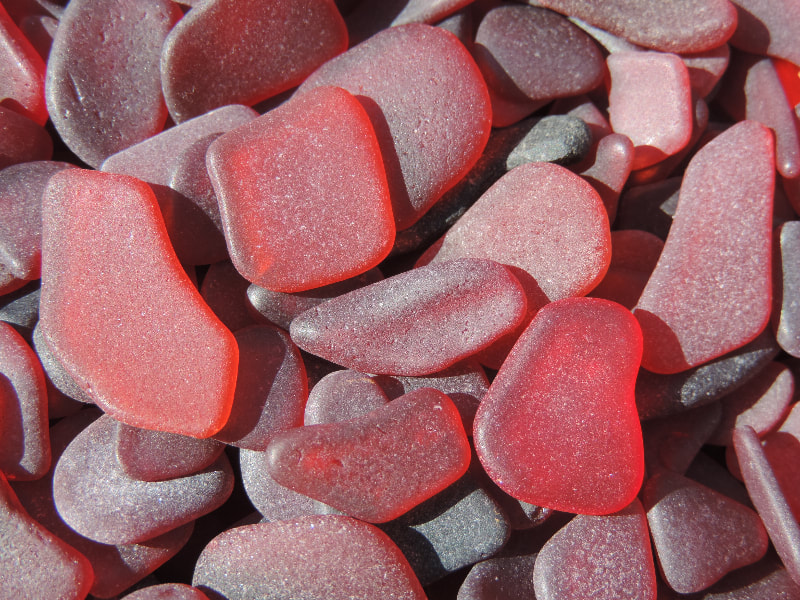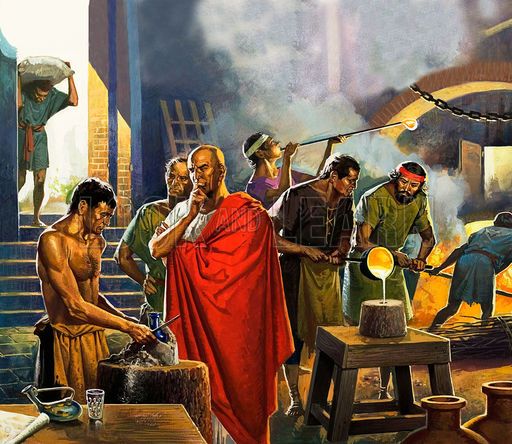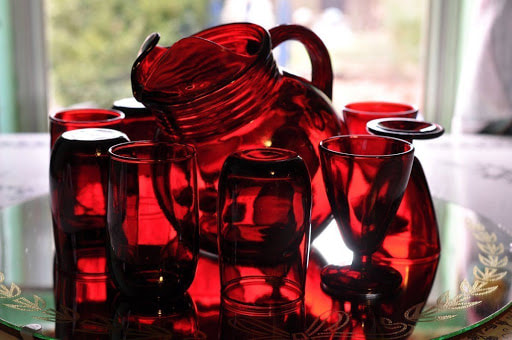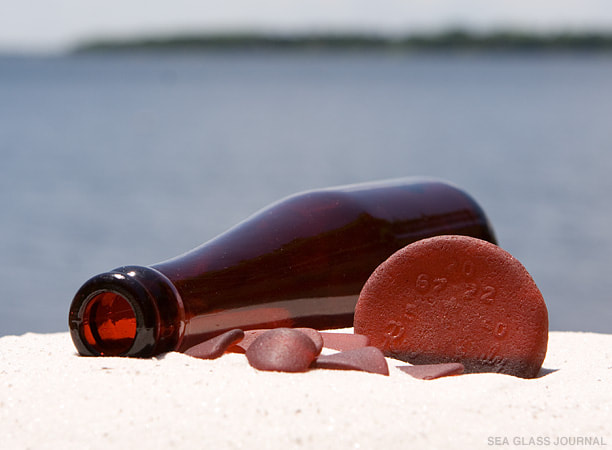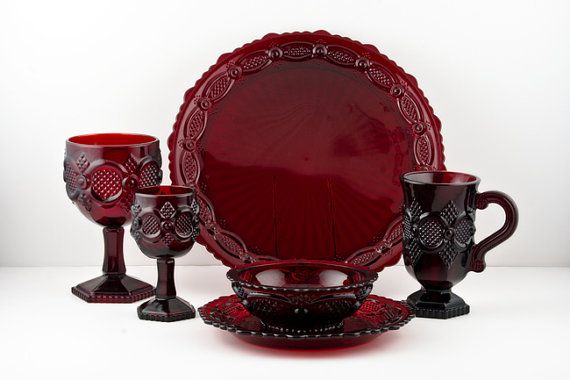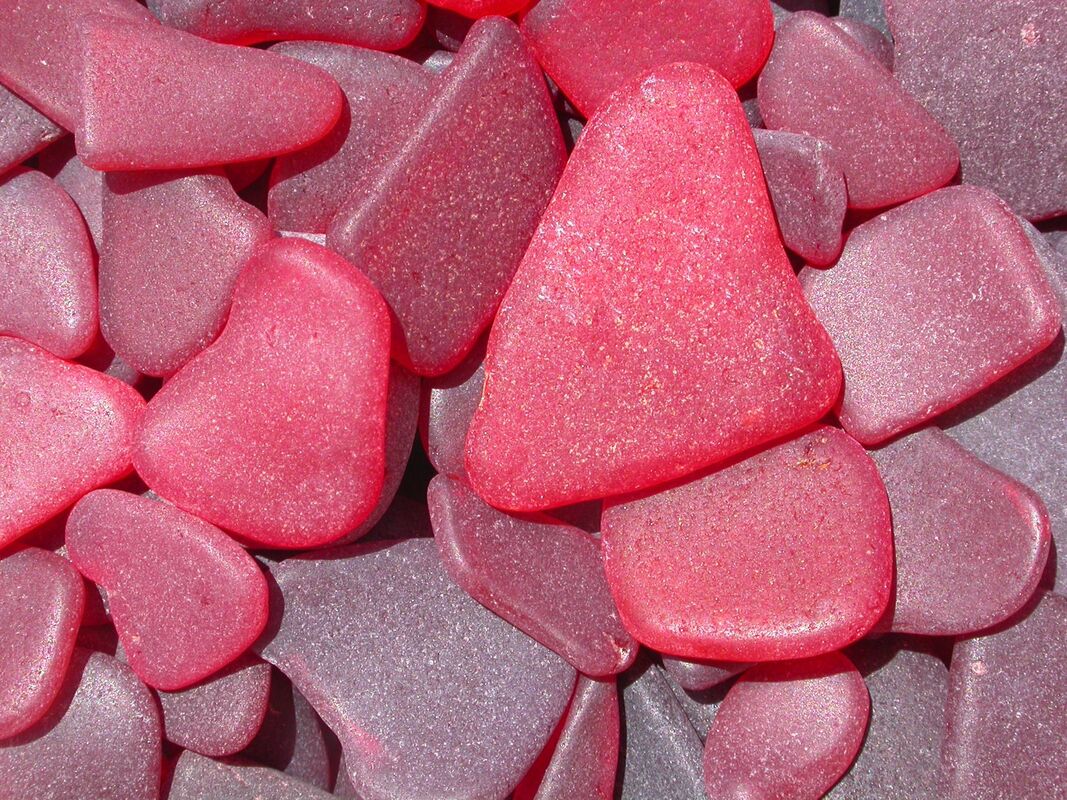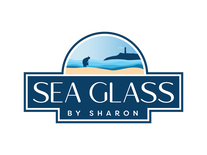Where Do Sea Glass Marbles Come From?
When it comes to beach treasures, sea marbles belong in the ‘holy grail’ category. In fact, they’re arguably the second most-prized find for any sea glass collector (behind only the legendary bottle-stopper).
Have you found any sea glass marbles on your beachcombing adventures? If so, I’m willing to bet you have them proudly on display; the jewels of your collection. Lord knows all mine are locked away for safe-keeping! But here’s a question. Just how did that little marble end up on the beach in the first place? Where did it come from, and why has it been in the ocean all these years? Well, sea glass enthusiasts have a lot of theories… Some are more accurate than others. A few are more rooted in myth and romanticism than reality. The truth is actually simpler than you might expect. Sea glass marbles are said to come from four main sources: ship ballast, Codd bottles, playing marbles, and railroad marbles. Of these, playing marbles make up the overwhelming majority, especially here on US shores. The others make up a tiny fraction of all sea glass marbles found, and in the case of ship ballast is more wive's tale than reality. But there's much more to the story than that. Each of these origins has a rich history to be told, full of adventure, innovation and colorful characters. It's time to clear up the truth about sea glass marbles, that great mystery of the sea glassing community. And we'll start with one of the great urban legends, passed down by collectors for generations... Source #1: Ship Ballast
In centuries past, sailing was risky business. Stormy weather and swift currents claimed many a vessel and her crew. For a captain, maintaining stability on the high seas was a matter of life or death.
That’s where ballast comes in. ‘Ballast’ is the term for any material stored in a ship’s keel, designed to keep the vessel upright and navigable. In the past, ballast typically consisted of heavy, solid materials like sand or rocks. This heavy weight belowdecks provided stability - reducing the risk of tipping or capsizing in turbulent conditions. Ballast was especially important for cargo ships, which would often travel empty prior to picking up cargo (or after unloading their cargo). If a captain were sailing from Boston to Liverpool to pick up goods, he would first load up on cheap sand and rocks. Once arrived in England, the ballast would be unloaded and replaced with precious (and heavy) cargo. And so the cycle repeated, substituting one form of ballast for another - and keeping sailors safe and dry.
So what does this have to do with marbles? Well the story goes, some captains decided to use marbles for their ballast. And why not? Marbles were more compact than rough rocks. They were durable and plentiful, especially in European markets. They were also relatively inexpensive to produce. And unlike sand or rocks, marbles had a resale market, so they could be sold upon arrival for a small supplementary profit.
Over time, boxes of these ballast marbles were left on distant shores. Some were dumped overboard mid-voyage. Still others were sent to the ocean floor with shipwrecked vessels. As the decades passed and their containers rotted away, the tough little marbles went on - scattering with the tides. Until one day they washed up ashore for a lucky beachcomber. Or so the story goes. The problem is, we don’t have any real evidence for this theory. Despite the odd tale and rumor, there’s little to suggest the stories are true. After all, marbles may have been cheap to produce, but sand and stone were FAR cheaper (often free in some circumstances!). Why would a captain cut into his profits by paying for marbles (which he would soon be disposing of), when he could pay a fraction of the price for sand or rocks? Even if marbles were used occasionally for ballast, it’s unlikely they would be the pretty colored marbles we’re used to. At the time, the most common (and cheapest) marbles being produced were made out of clay. These earthenware marbles were mass-produced in their natural colors; tans, whites, and browns. Dyes were rarely used, since this only added to production costs. So sadly, if you were to find a ballast marble, it would likely be the ugly duckling of your collection!
It’s hard to deny that the story of the ballast marble is nothing short of romantic. Unfortunately, it’s more rooted in folklore than reality. But that won’t stop it from being one of the most popular and fun legends of the sea glassing community!
[QUICK ASIDE] While times have changed, the need for ballast is just as important today as it was in ancient times. Modern vessels have dispensed with solid ballast material like rocks and sand however. It has been substituted with free and accessible sea water, which can be pumped in and out of tanks in ship keels for quick buoyancy adjustments. Neat, huh?! Source #2: Codd Bottles
Ah, the Codd-neck bottle. For my brits out there, these are sure to bring about nostalgic feelings. For us Americans, the Codd bottle is shrouded in mystery.
You see, in the late 1800’s an inventor from London, Hiram Codd, created a revolutionary new bottle design. Importantly, the design used a marble and rubber washer to seal carbonated drinks and keep them from going flat. Codd’s bottle was remarkably effective, and far cheaper to manufacture than traditional cork stoppers. The bottle soon spread like wildfire, and Hiram Codd became a rich man. For decades, the Codd-neck bottle was the container of choice for soft drink manufacturers and brewers across Europe, India, and Australasia. Eventually they would fade into history due to sanitary concerns and the obvious choking risk. However, Codd bottles remain fan-favorite collector’s items, especially in the United Kingdom. They are even still used to bottle some soft drink brands in Japan (Ramune) and India (Banta)!
There’s no doubt that many of these bottles (and their precious marbles) found their way into oceans and coastal dumps. Children would often smash them open to play with the marble inside. Could these Codd marbles be the same ones washing up on our shores?
Possibly. If you live in Europe (especially England), your chances are certainly much higher. The same goes for former British colonies in the Caribbean and Asia. For us Americans however, it’s doubtful that Codd bottle marbles make up more than a tiny fraction of those found on our shores. The Codd-neck bottle never really caught on in the United States, and their marbles would have to make quite the journey to cross the Atlantic. More likely, Codd marbles are a localized find, contained mostly to Northern Europe. But that doesn’t make them any less stunning in person! I’m jealous of all our friends across the pond who get to stumble upon these gems during a beachside stroll. If you’ve ever found one, send me pictures! Source #3: Playing Marbles
Did you know that marbles are among the world’s oldest games? Marbles have been found in Egyptian tombs and in the ashes of Pompeii. They were a part of Roman, Greek, Aztec, and Native American culture. I would also argue playing marbles make up the vast majority of sea glass marbles found on our American shores. While ancient marbles were mostly made of stone or clay, glass marbles became an international sensation in the mid-1800’s thanks to German innovation. German producers dominated the market for many decades, until American entrepreneurs began to vie for a share in the late 19th century. By the 1920s and ‘30s, playing marbles had become an American institution, for children and young adults alike. There were dozens of game variations, plus marble racing, jacks, slingshots - not to mention collecting and decorative displays. High competition among producers made marbles plentiful and cheap; the number of marbles made is estimated in the billions. 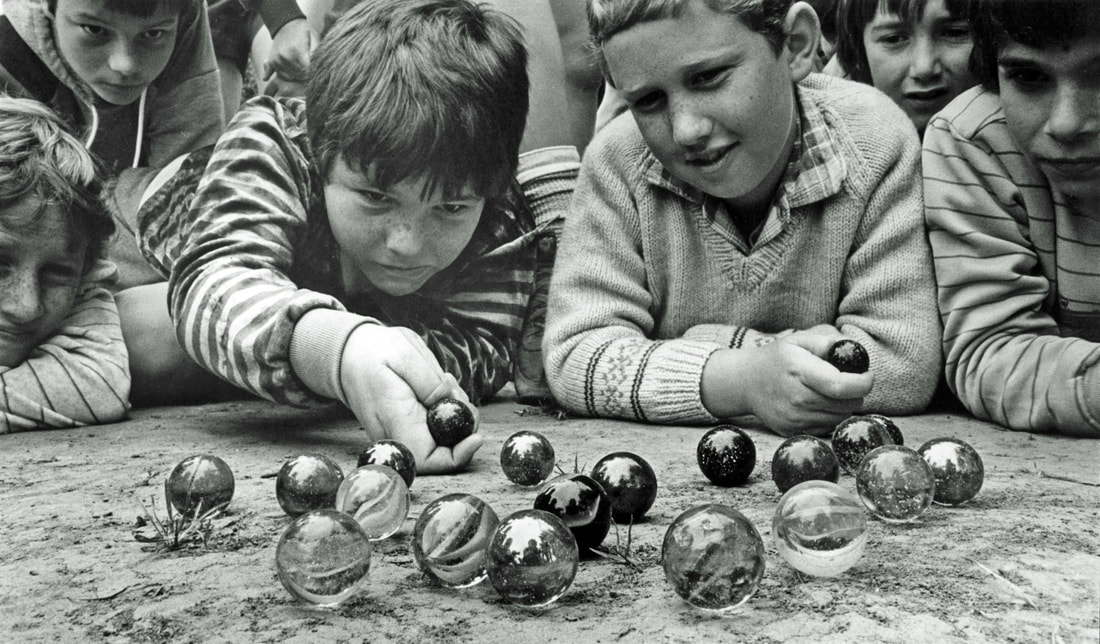 Photo Credit: Hawke’s Bay Knowledge Bank Photo Credit: Hawke’s Bay Knowledge Bank
Marble popularity would begin to wane around World War II, much due to industrial rationing and the devastation of Europe. After the introduction of the cat’s-eye marble by the Japanese in the 1950s, American producers began to exit the game. Shortly after, playing marbles faded into the pages of history. Despite brief resurgences, marbles have never recaptured the magic of the early 20th century.
But what happened to all those billions of marbles? Well, lots of them found their way into our oceans! Think about all the kids who used to bring their marbles to the beach during summer vacations! Many would have raced their collection down sand dunes. Others would have skipped, thrown, and shot their marbles into the surf. Still some may have hurled marbles from slingshots at passing gulls! And let’s not forget all the marbles left behind when mom was in a rush to pack up and leave. Even more marbles likely found their way to our seas via coastal dumps. You see, as children grew up, those marble collections would often find their way into the trash. And in the past, dumps were frequently located along rivers and waterways, which would flow to the ocean. For coastal communities, dumps could be found along bays and sea-bluffs. Erosion, tides, and time brought many a lost marble into oceanic currents. Until one day - decades later - they resurfaced on your beach! Just imagine how many marbles are out there waiting to be plucked from the surf. My guess is we’ll be picking up sea glass marbles for centuries to come. Source #4: Railroad Marbles
Ever heard of a ‘railroad marble’? If you don’t live near antique railways along the east coast, you probably haven’t! But many point to these as a fourth source of sea glass marbles. Let’s find out why.
The story dates back to the late 1800’s and the Baltimore and Ohio Railroad, the oldest railroad in the United States. B&O officials asked for a marble that could ‘hold 500 pounds’, commissioning Wheeling Glassworks to produce tons for their enterprise. We know this much is true at least; you can still find marbles today along antique railways, stations, and freight houses - particularly in the east coast. Moving forward though, accounts get a bit muddied. Some argue these marbles were used as cushion underneath railroad tracks, supporting them as massive trains rolled overtop. This reduced pressure on rails, dispersing weight underneath and reducing track breakdowns. Others claim the marbles were instead used in freight houses and depots, as a cheap way to move cargo. A bed of tracks and marbles would be laid out in a path, allowing heavy cargo to be ‘rolled’ along to its final destination. Regardless of the use, some sea glass collectors believe these marbles found their way into local waterways, eventually meeting the sea and washing up ashore on our beaches decades later. It’s a lovely story, and probably true to a small extent. But I find it hard to believe these railroad marbles make up more than a tiny fraction of our beach marbles.
For one, if you’ve ever seen one of these marbles, you know they’re a bit of an eyesore. Of course, any marble intended for industrial purposes is going to be made as cheaply and simply as possible. Most feature a rough seam indent running along the middle, where both halves were forged together during manufacturing. They commonly have large air bubbles inside, and come in a pale green color. You’re unlikely to find the vivid colors or beautiful catseye patterns so popular among sea glass collectors. Sadly, these little marbles aren’t going to be the gems of your collection anytime soon.
Even so, I think you’re far more likely to find these along interior waterways than ocean shores. Keep your eye out along local creeks, rivers, and lakes - especially if it’s home to antique rail lines. You may just find a piece of American history! Even if it is a bit of an ugly duckling. Wrapping Up
In the end, sea glass marbles will always be surrounded by legends and mystery. And that’s part of their charm! There’s a reason marbles have captivated beach collectors for decades.
The reality might be a bit simpler, but that doesn’t detract from their colorful history. Each little orb has gone through quite the journey to wind up on your shore. It’s a one-of-a-kind snapshot of the past, now and forever in your possession. Display it proudly! Have you found any special sea glass marbles? I would love to see them! Share them with me on Facebook or Instagram. If you’d like, I’ll even wrap it into a custom necklace, bracelet, or earring for you! And if you'd like to read more about the history of rare beach finds, check out my article on where red sea glass comes from. Happy hunting! Where Does Red Sea Glass Come From?
Do you remember your first piece of red sea glass? I do.
I was walking along the shore, feet sandy and sore after a long day of beachcombing. It was a typical spring day in New England; a warm breeze, the salty air, the faint sound of rustling dune grass... I was about to turn back and head for home. And then I spotted it.
It was blazing like fire. Caught in the sun’s reflection; the most beautiful red I had ever seen. Like a ruby swimming in a sea of gold. My heart dropped.
Since that day, the reds have kept coming, but the excitement has never waned. Even today, a single piece of red can change my day from disappointing dud to roaring success - all in an instant. But why? What is this magic that red sea glass casts upon beach-lovers? Why has it captured the hearts and imaginations of the sea glassing community for so long?
Today, we’re going to explore those questions and more. Why is red sea glass so rare? What is its history? And most importantly, what are its origins?
Generally, red sea glass comes from four main sources: antique Anchor Hocking glass, discarded Schlitz beer bottles, a once-popular Avon collection, and industrial products such as signal lanterns and car and boat lights. But the story doesn't end there. Each of these origins has a rich and colorful history worth exploring. But before we begin, we need to go back to where it all started. The ancient origins of red glass; and the roots of its rarity. And like many a prized thing, it all begins with a legend... The History of Red Sea Glass: Ancient Legends
The story goes, a nobleman from long ago was once mixing molten glass. Preoccupied, the careless man accidentally dropped his golden ring into the inferno. His mood changed from outrage to wonder as the glass before him turned a wonderful shade of ruby-red.
The legend has long-since been disproven, with experts saying the experiment would “only result in a puddle of melted gold at the bottom of the vat.” But like all myths, it contains a hint of truth. For, up until modern times, most red glass had its origins in one key element. Gold. No wonder it’s so prized! The ‘gold-standard’ for collectors, red sea glass can be traced back to… well, gold itself!
Over the centuries, the recipe was sought after by kings and metallurgists - repeatedly lost and rediscovered. But it always remained consistent. When mixed with gold (and often trace amounts of tin), glass produced a majestic ruby color. By changing the amount of gold added, one could adjust the color hue, from deep red to bright cranberry.
Gold was obviously a rare and expensive material, meaning red glass was exclusive to royalty and the elite. Glassmakers experimented with cheaper, more common materials such as copper and manganese, but found little success. They were able to produce reddish tones, but nothing like the prized ‘gold-ruby’ of the age. Red glass would remain a luxury of the wealthy, produced only in limited batches. In its heyday, roughly around the late 1600’s, gold-ruby glass was cherished by kings and queens across Europe. From Venice to Prague to Hamburg, royalty collected red glass vessels to line their tables and halls. Later, in Victorian England the fashion would be rediscovered, as nobles pressed intricate patterns into their prized gold-ruby possessions. Here in the fledgling United States, red glass was considerably less in-fashion. To common-folk Americans, it was virtually unknown. Not until the late 1800’s did it begin to catch on with the elite, popularly referred to as ‘Cranberry Glass’ and displayed as decorative tableware. But for the most part, high production costs limited the spread of red glass. It was prohibitively expensive to mass-produce, and so remained a rare good. That was, until a new and innovative company emerged on the scene. Where Does Red Sea Glass Come From?Anchor Hocking
Much of today’s red sea glass craze can be traced back to a single source. The Anchor Hocking Glass Corporation. Over the past century, beach-goers have been unknowingly collecting their little castaways from US shores.
In 1938, Anchor Hocking (re)discovered the secret to cheaper red glass production. They called it ‘Royal Ruby’, and it was created by substituting precious gold with common copper. Without gold, the glass turned a deep, darker shade of red. But copper made red glass commercially feasible for producers. And that meant it soon became more accessible (and affordable) for America’s middle and upper classes. Royal Ruby was soon being mass-produced from Anchor Hocking factories in Ohio, New Jersey, and Pennsylvania.
It spread like wildfire. Royal Ruby would appear in kitchens and dining rooms across the United States. It took the form of fancy dinnerware and decorative household items; plates, vases, cups, platters, bowls, brandy snifters, and more.
It became so popular that Anchor Hocking was eventually approached by an unusual source. And this source wanted to place Royal Ruby in barrooms and refrigerators across the country. Joseph Schlitz Brewing Company
That’s right; Schlitz, the pride of Milwaukee. Did you know Schlitz beer was once bottled in Anchor Hocking’s Royal Ruby? Long forgotten and discarded, these reds make prized collector’s items for many a beachcomber.
The story goes, with the company’s 100-year anniversary on the horizon, Schlitz wanted to celebrate with a special presentation. They reached out to Anchor Hocking, whose Royal Ruby line was quickly becoming a household name. Agreements were made, along with prototypes and designs, and by late 1949 the first bottles were shipped. Schlitz, the ‘King of beer’, now in dark, Royal Ruby glass. Between 1949-1950, some 50 million red Schlitz bottles were produced. 50 million!
Unfortunately, the bottles found little success with customers. For beer-drinkers, there was just something off-putting about swigging ale out of a red bottle. They much preferred the traditional brown and clear colors, and the Royal Ruby bottles were discontinued. Thirteen years later, when Schlitz tried to revive the red bottles once more, they met so much resistance that the idea was abandoned forever.
Beer-drinkers may not have loved Royal Ruby, but sea glass fans sure do! Some seventy years later, these reds remain some of the most treasured finds for long-time collectors. This is especially true for the bottle ‘bottoms’; priceless gems occasionally found intact in one circular chunk. Many Schlitz reds feature a unique cursive script embossed on the glass, making them easier to identify for sharp eyes. But Anchor Hocking and Schlitz Brewing weren’t the only brands to jump on the red glass bandwagon. Some 20 years later, another company hoped to follow suit with a line of their own. Avon
Yep, that’s right. Avon, the iconic ‘door-to-door’ cosmetics brand is another major source of red sea glass.
It was called the ‘1876 Cape Cod Collection’. Avon’s first foray into dinnerware lines, introduced in the mid-1970’s. And it was soon to be a national obsession. The design was based on a lacy ‘Sandwich’ pattern, a classic style popularized in Cape Cod back in the 19th and early 20th centuries. Produced by New Jersey-based Wheaton Glass, the collection became famous for its dark red hue - reminiscent of the Royal Ruby of old. Soon, homes across America were filling up with red glassware from Avon. In fact, the Cape Cod Collection was so popular that Avon continued to expand the line for almost two decades, until it was finally discontinued in 1995.
In all, 37 different pieces were designed. There was the classic dinnerware: bowls, plates, platters, cake and butter dishes, gravy boats, creamers, cup and saucers, and mugs. And then there were the decorative items: candle holders, bells, trinket boxes, decanters, cruets, perfume holders, shakers, napkin rings, and more.
If you’re a ‘seasoned’ collector like myself, you probably remember these from your childhood - they were everywhere! If not, you’ve probably seen them at flea markets or garage sales. Over the years, these collectors items found themselves in junkyards and glass dumps along the coast. Eventually they found their way to the sea, washing up ashore - some decades later - as lucky beachcombing prizes! Signal Lanterns, Tail Lights, and More!
What about the rest of our red sea glass? It can’t all come from Anchor Hocking, Schlitz bottles, and Avon, right?
True! The remainder comes from a variety of sources, manufactured in the mid and early 1900’s. The largest of these include:
By the 1950’s, red glass was being replaced by much cheaper forms of plastic. Over the years, that red glass was lost to the coastal junkyards and ocean floors. Lost to the waves and the swirling currents. Until one day, it caught a friendly tide and washed ashore... Wrapping Up
Someday soon, one of you lucky readers will stumble upon a piece of red sea glass. On that day, I hope you stop and reflect for a moment. What a journey that little ruby has been on!
Where did your piece’s story begin? Did it once adorn the tables of the rich and powerful? Did it house a frosty beverage at the local pub? Or did it once sail the high seas with burly sailors? That, my dear friends, is best left to the imagination. |
�
AuthorJust a New England beachcomber, dreaming of waves and sea glass... ArchivesCategories |
4 Park St, Unit 6, Newburyport, MA 01950
Copyright © 2019
